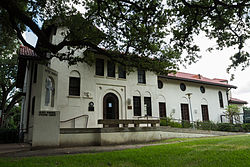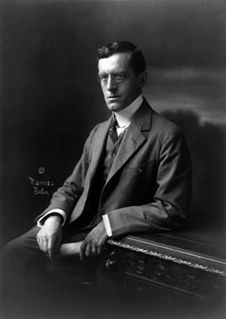
Ralph Adams Cram was a prolific and influential American architect of collegiate and ecclesiastical buildings, often in the Gothic Revival style. Cram & Ferguson and Cram, Goodhue & Ferguson are partnerships in which he worked. Together with the architect Richard Upjohn and artist John LaFarge, he is honored on December 16 as a feast day in the Episcopal Church of the United States. Cram was a fellow of the American Institute of Architects.

The Church of the Intercession is an Episcopal congregation located at 550 West 155th Street, at Broadway, on the border of the Harlem and Washington Heights neighborhoods of Manhattan, New York City, on the grounds of Trinity Church Cemetery. The congregation was founded in 1846, and the current sanctuary, built in 1912-15, was designed by Bertram Grosvenor Goodhue in the Gothic Revival style. From 1906-1976, it was a chapel of Trinity Church.

Bertram Grosvenor Goodhue was an American architect celebrated for his work in Gothic Revival and Spanish Colonial Revival design. He also designed notable typefaces, including Cheltenham and Merrymount for the Merrymount Press. Later in life, Goodhue freed his architectural style with works like El Fureidis in Montecito, one of the three estates designed by Goodhue.

Trinity Church, in Midtown Houston, Texas, is a parish church in the Episcopal Diocese of Texas.

The Calcutta Boys' School was founded by the Rev. James Mills Thoburn, and was opened in 1877. It was endowed by Robert Laidlaw and others interested in the education of the sons of the Anglo-Indian and domiciled European community.

Ruge Hall is a historic site in Tallahassee, Florida. It is located at 655 West Jefferson Street. On August 1, 1997, it was added to the U.S. National Register of Historic Places.
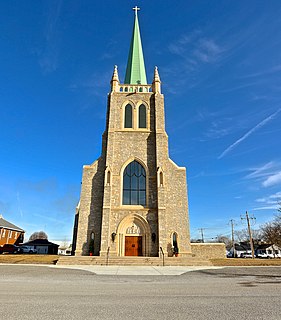
Cram and Ferguson Architects, original partnership was founded in 1889 by the "preeminent American Ecclesiastical Gothicist" Ralph Adams Cram and Charles Francis Wentworth. In 1890 they were joined by Bertram Goodhue, who was made a partner in 1895.
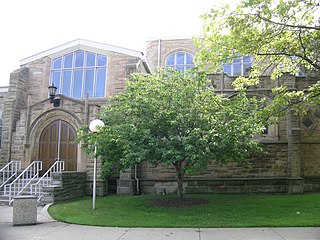
Saint Andrew's Memorial Episcopal Church is a historic church located in Detroit, Michigan. As of 2008, it is used by Wayne State University and referred to as St. Andrew's Hall. The church was listed on the National Register of Historic Places in 1986.

Trinity Episcopal Church is located at 1519 Martin Luther King Boulevard in the Woodbridge Historic District of Detroit, Michigan. The church was designated a Michigan State Historic Site in 1979 and listed on the National Register of Historic Places in 1980. It is now known as Spirit of Hope.
William Ward Watkin was an architect primarily practicing in Houston, Texas. He was the founder of the Architecture Department of Rice University in 1912, and remained on the Rice faculty until his death. Concurrently, he also designed a number of important projects, mostly in the Houston area.

The University-Cultural Center MRA is a pair of multiple property submissions to the National Register of Historic Places which were approved on April 29 and May 1, 1986. The structures included are all located in Midtown, near Woodward Avenue and Wayne State University in Detroit, Michigan. The two submissions are designated the University-Cultural Center MRA Phase I, containing five properties, and the University-Cultural Center MRA Phase II, containing three properties.

St. Andrew's Episcopal Church is located at North Main and Madison avenues in Albany, New York, United States. It is a complex of three buildings, centered on the church itself, a stone structure designed by architect Norman Sturgis in the Late Gothic Revival architectural style and built in 1930. In 2005 it was listed on the National Register of Historic Places.

St. Andrew's Episcopal Church, is an Anglo-catholic church in Denver, Colorado. Its building, "considered by many people to be one of Denver's most beautiful churches" is a Gothic style church built c.1907-1909 that was designed by architect Ralph Adams Cram. It was dedicated January 17, 1909 as Trinity Memorial Church and renamed to St. Andrews in 1917.
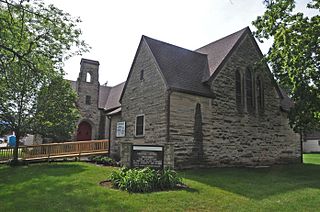
St. Luke's Methodist Church is a Late Gothic Revival church in Monticello, Iowa whose church building was completed in 1950. It is now the Monticello Heritage and Cultural Center. It is the only church in Iowa designed by nationally prominent architects Cram & Ferguson, who specialized in ecclesiastical architecture.
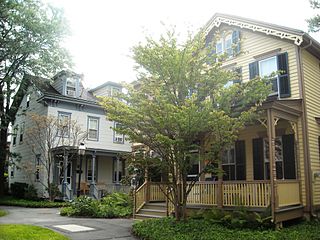
The Princeton Historic District is a 370-acre (150 ha) historic district located in Princeton, New Jersey that was listed on the U.S. National Register of Historic Places in 1975. It stretches from Marquand Park in the west to the Eating Clubs in the East, from the Princeton Cemetery in the north to the Graduate College in the south. The district encompasses the core parts of the campuses of the Princeton Theological Seminary and Princeton University. It also includes the business district centered on Nassau Street and many historic homes, both mansions in the western section and more humble dwellings in the Witherspoon/Jackson neighborhood. Notable churches within the district include Nassau Presbyterian Church, Trinity Episcopal, Nassau Christian Center, and the Princeton University Chapel. The district is home to seven of Princeton's nine, and New Jersey's fifty-eight, National Historic Landmarks, the largest concentration of such sites in the state.

Gibson Memorial Chapel and Martha Bagby Battle House at Blue Ridge School is a historic Episcopal chapel and home located on the grounds of Blue Ridge School near Dyke, Greene County, Virginia.

George DeWitt Mason was an American architect who practiced in Detroit, Michigan in the latter part of the 19th and early decades of the 20th centuries.
James L. Autry House may refer to:
